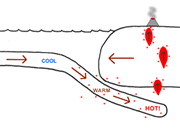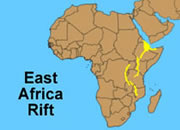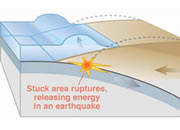Three Parts of Earth's Interior |
 |
A knowledge of earth's interior is essential for understanding plate tectonics. A good analogy for teaching about earth's interior is a piece of fruit with a large pit such as a peach or a plum. Most students are familiar with these fruits and have seen them cut in half. In addition, the sizes of the features are very similar.
If we cut a piece of fruit in half, we will see that it is composed of three parts: 1) a very thin skin, 2) a seed of significant size located in the center, and 3) most of the mass of the fruit being contained within the flesh. Cutting the earth we would see: 1) a very thin crust on the outside, 2) a core of significant size in the center, and 3) most of the mass of the Earth contained in the mantle.
Earth's Crust |
 |
There are two different types of crust: thin oceanic crust that underlies the ocean basins, and thicker continental crust that underlies the continents. These two different types of crust are made up of different types of rock. The thin oceanic crust is composed of primarily of basalt, and the thicker continental crust is composed primarily of granite. The low density of the thick continental crust allows it to "float" in high relief on the much higher density mantle below.
Earth's Mantle |
 |
Earth's mantle is thought to be composed mainly of olivine-rich rock. It has different temperatures at different depths. The temperature is lowest immediately beneath the crust and increases with depth. The highest temperatures occur where the mantle material is in contact with the heat-producing core. This steady increase of temperature with depth is known as the geothermal gradient. The geothermal gradient is responsible for different rock behaviors, and the different rock behaviors are used to divide the mantle into two different zones. Rocks in the upper mantle are cool and brittle, while rocks in the lower mantle are hot and soft (but not molten). Rocks in the upper mantle are brittle enough to break under stress and produce earthquakes. However, rocks in the lower mantle are soft and flow when subjected to forces instead of breaking. The lower limit of brittle behavior is the boundary between the upper and lower mantle.
Earth's Core |
 |
Earth's Core is thought to be composed mainly of an iron and nickel alloy. This composition is assumed based upon calculations of its density and upon the fact that many meteorites (which are thought to be portions of the interior of a planetary body) are iron-nickel alloys. The core is earth's source of internal heat because it contains radioactive materials which release heat as they break down into more stable substances.
The core is divided into two different zones. The outer core is a liquid because the temperatures there are adequate to melt the iron-nickel alloy. However, the inner core is a solid even though its temperature is higher than the outer core. Here, tremendous pressure, produced by the weight of the overlying rocks, is strong enough to crowd the atoms tightly together and prevents the liquid state.
Contributor: Hobart King
Publisher, Geology.com
Find Other Topics on Geology.com:
 | Rocks: Galleries of igneous, sedimentary and metamorphic rock photos with descriptions. |
|
 | Minerals: Information about ore minerals, gem materials and rock-forming minerals. |
|
 | Volcanoes: Articles about volcanoes, volcanic hazards and eruptions past and present. |
|
 | Gemstones: Colorful images and articles about diamonds and colored stones. |
|
 | General Geology: Articles about geysers, maars, deltas, rifts, salt domes, water, and much more! |
|
 | Geology Store: Hammers, field bags, hand lenses, maps, books, hardness picks, gold pans. |
|

|
 | Diamonds: Learn about the properties of diamond, its many uses, and diamond discoveries.
|
|





















